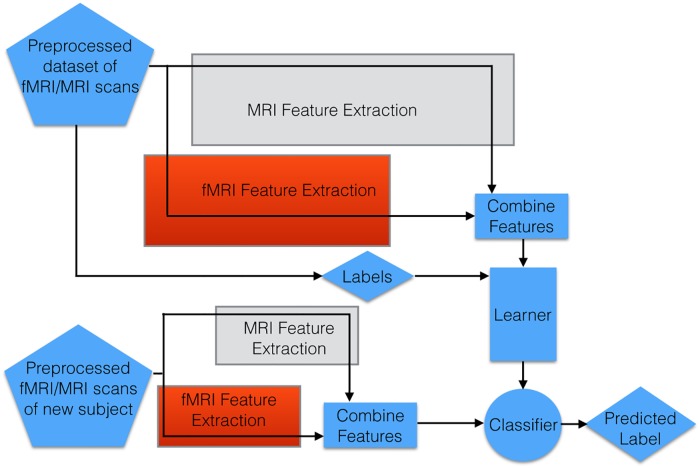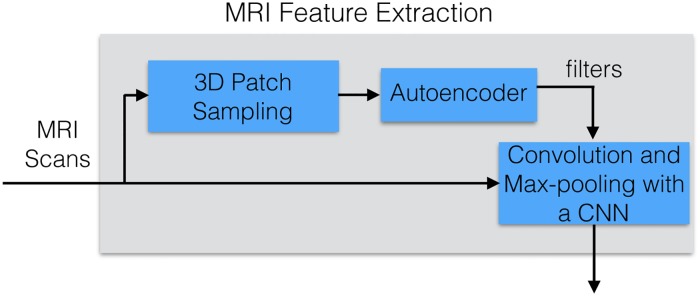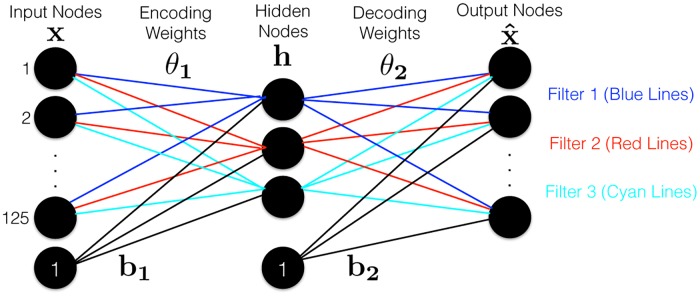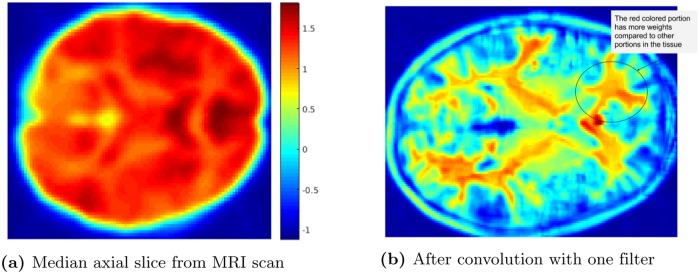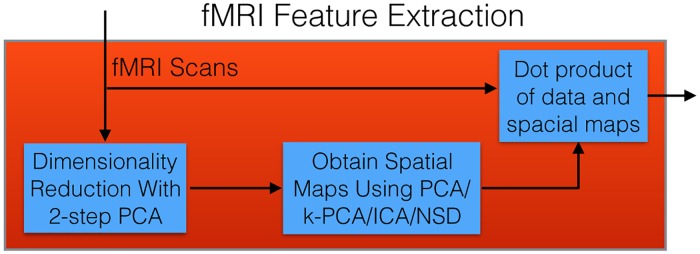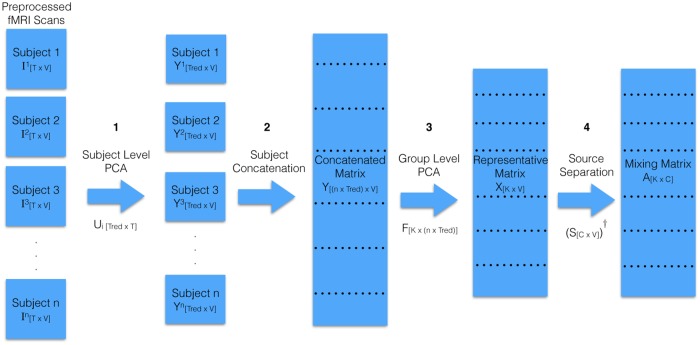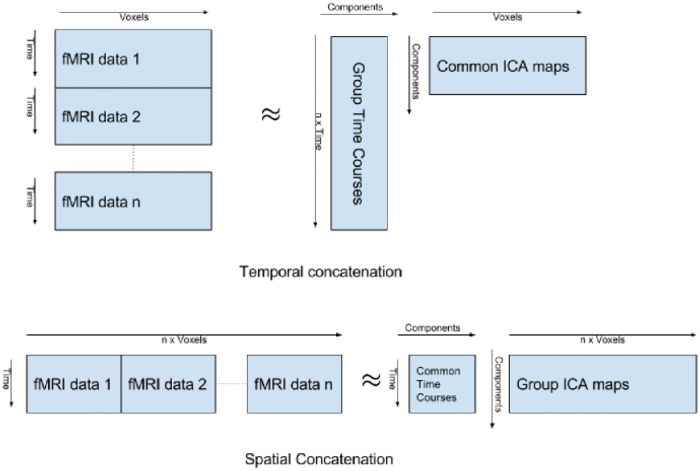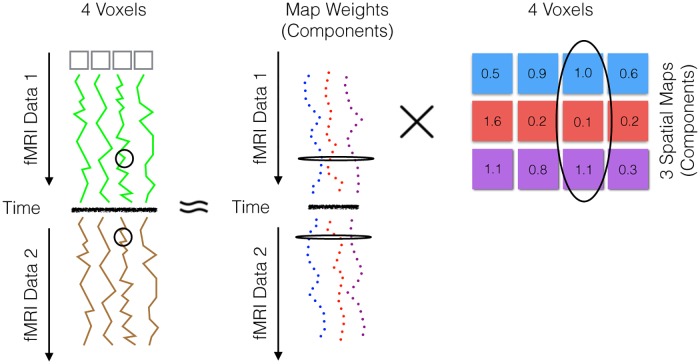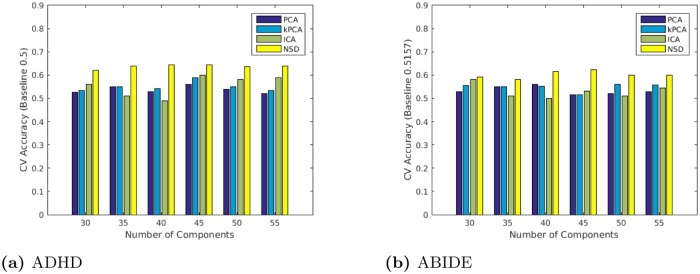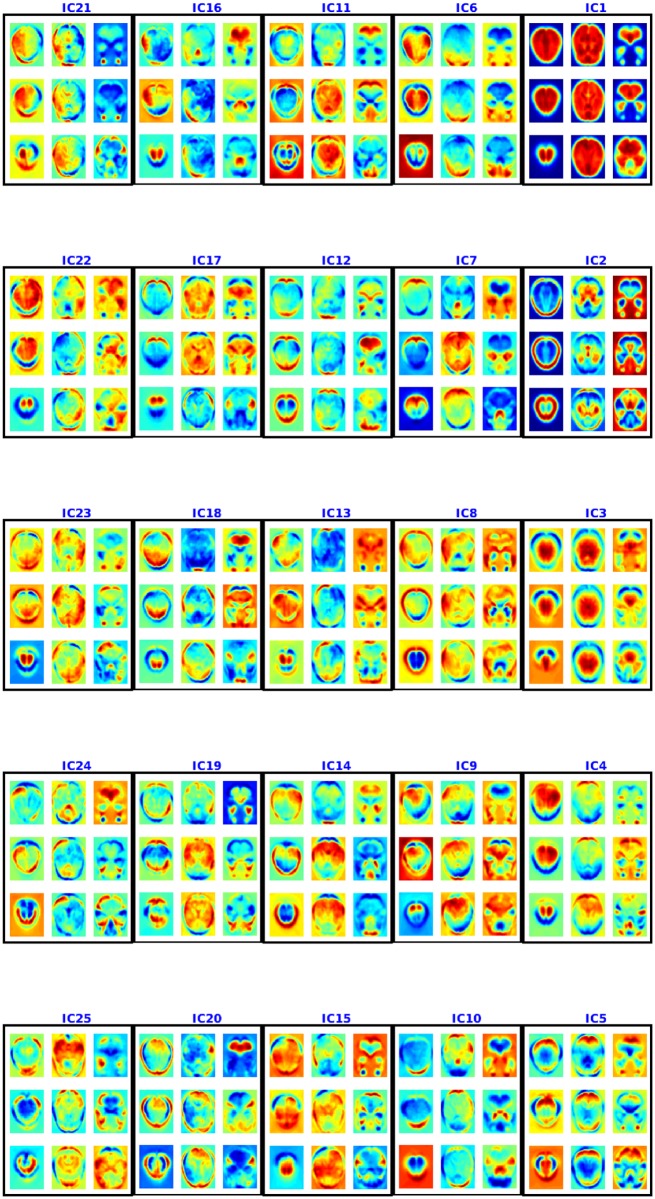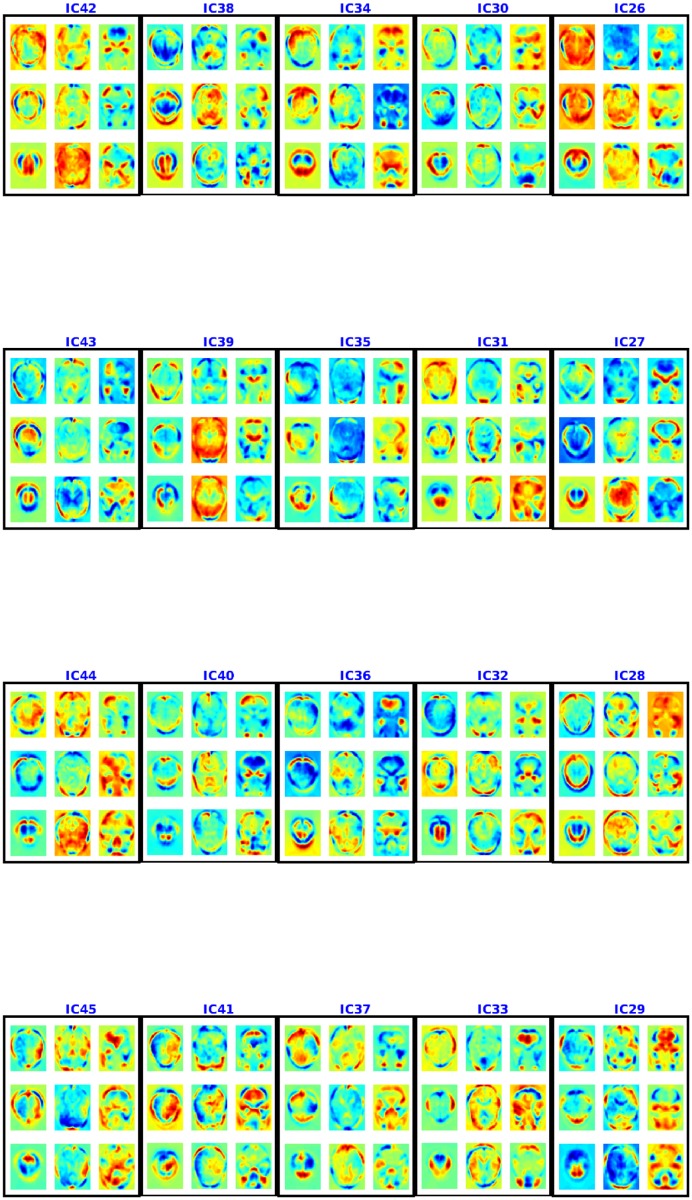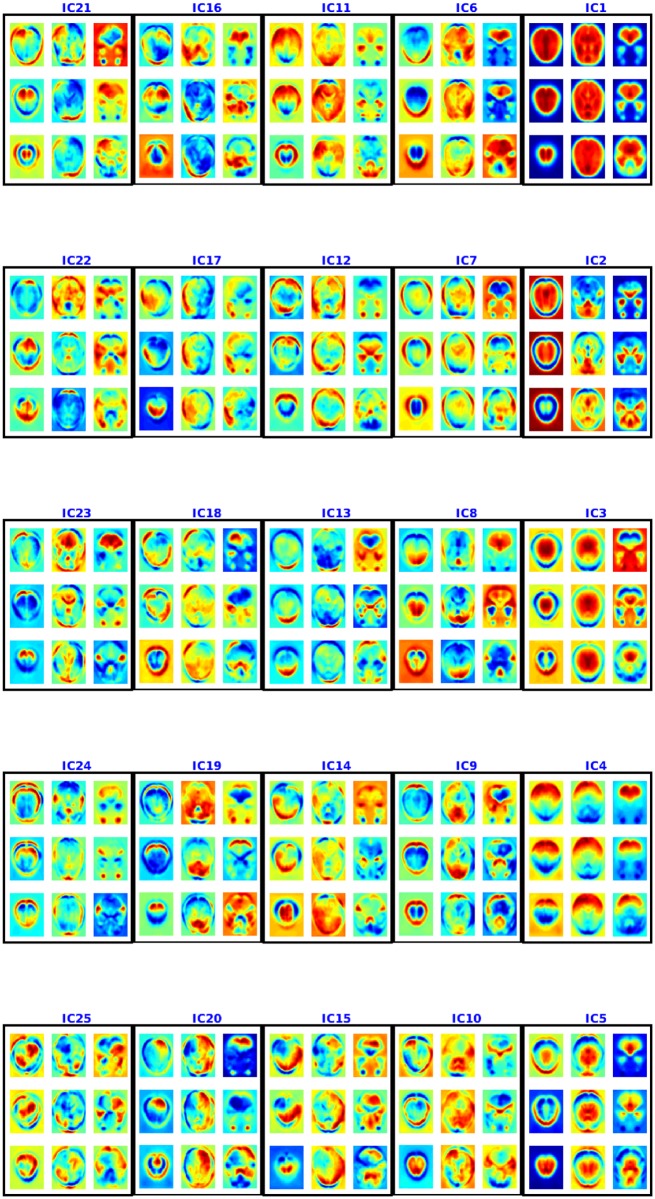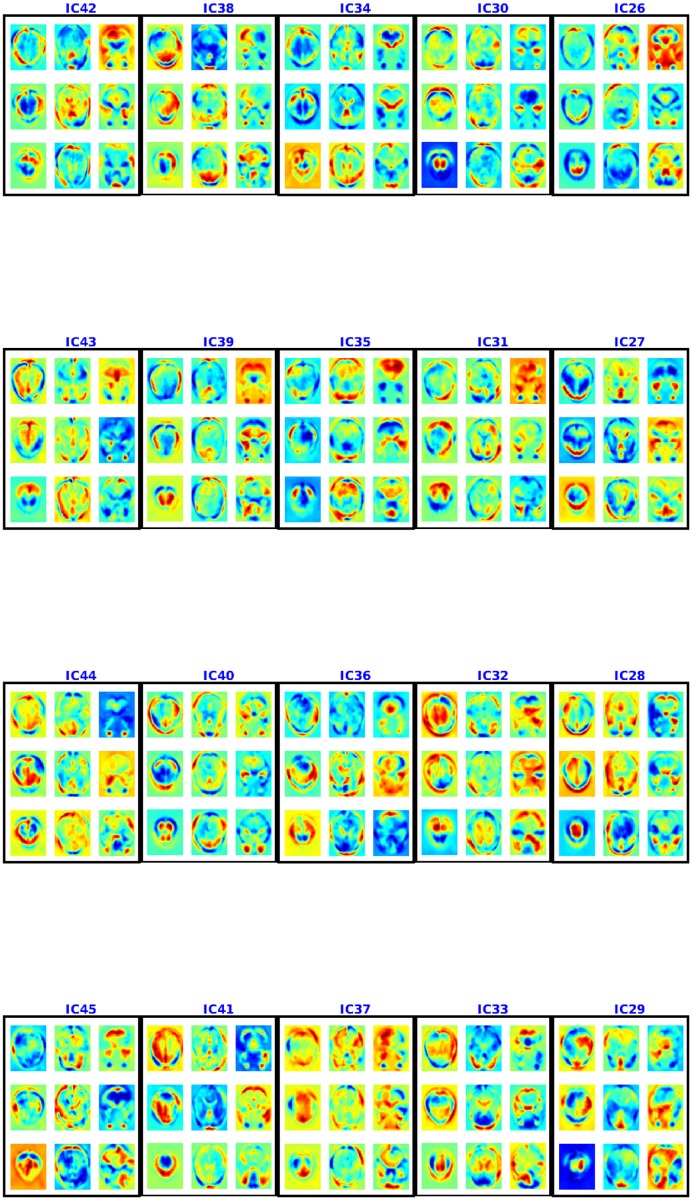Abstract
This work presents a novel method for learning a model that can diagnose Attention Deficit Hyperactivity Disorder (ADHD), as well as Autism, using structural texture and functional connectivity features obtained from 3-dimensional structural magnetic resonance imaging (MRI) and 4-dimensional resting-state functional magnetic resonance imaging (fMRI) scans of subjects. We explore a series of three learners: (1) The LeFMS learner first extracts features from the structural MRI images using the texture-based filters produced by a sparse autoencoder. These filters are then convolved with the original MRI image using an unsupervised convolutional network. The resulting features are used as input to a linear support vector machine (SVM) classifier. (2) The LeFMF learner produces a diagnostic model by first computing spatial non-stationary independent components of the fMRI scans, which it uses to decompose each subject’s fMRI scan into the time courses of these common spatial components. These features can then be used with a learner by themselves or in combination with other features to produce the model. Regardless of which approach is used, the final set of features are input to a linear support vector machine (SVM) classifier. (3) Finally, the overall LeFMSF learner uses the combined features obtained from the two feature extraction processes in (1) and (2) above as input to an SVM classifier, achieving an accuracy of 0.673 on the ADHD-200 holdout data and 0.643 on the ABIDE holdout data. Both of these results, obtained with the same LeFMSF framework, are the best known, over all hold-out accuracies on these datasets when only using imaging data—exceeding previously-published results by 0.012 for ADHD and 0.042 for Autism. Our results show that combining multi-modal features can yield good classification accuracy for diagnosis of ADHD and Autism, which is an important step towards computer-aided diagnosis of these psychiatric diseases and perhaps others as well.
1 Introduction
Statistical machine learning methods have recently permeated disciplines such as Psychiatry, which specializes in the diagnosis and treatment of neuropsychiatric disorders [1]. The availability of large scale neuroimaging datasets has encouraged researchers to develop computer-aided tools and procedures for understanding the human brain and its disorders. Some studies use structural Magnetic Resonance Imaging (MRI) scans, which provide a non-invasive technique for obtaining a volumetric image of the brain anatomy, while others use functional MRI (fMRI) scans, which measure brain activity by detecting fluctuations in the Blood Oxygenation Level Dependent (BOLD) signal over time.
Many neuroscientists are seeking ways to use such MRI and/or fMRI data to detect brain function disorders, such as Autism and Attention Deficit Hyperactivity Disorder (ADHD). While significant work has been done in association studies for finding discriminative group-level characteristics for ADHD [2–4] (resp., Autism [5, 6]), we are seeking a general learning tool that, when given relevant data, can learn an accurate predictive model, which can predict whether an individual subject has a particular disease. This paper explores biologically naive ways to learn combinations of state-of-the-art structural texture features (from structural MRI scans) and functional connectivity (from fMRI scans) to predict whether a subject has ADHD (resp., Autism). Specifically, our learned models use recently-developed unsupervised feature learning from images and independent component analysis of fMRI for prediction of the diseases.
From brain images, the structural textures provide information about the spatial arrangements of voxel intensities in 3 dimensions, which in turn can describe neurological aspects of a subject’s brain. On the other hand, functional connectivity captures patterns of deviations from statistical independence between the time signals at distributed, and often spatially remote, neuronal regions [7–9]. Deviations from statistical independence are generally taken to indicate dynamic coupling and can be measured, for example, by estimating the correlation, independent components, etc.
As a first step towards creating a generalized prediction tool for ADHD/Autism, we experiment with 3-D texture based models that describe structural arrangements of the brain by learning texture features from MRI scans. These features are then used by our LeFMS learner. To use the fMRI data, we experiment with four different source separation techniques, that each decompose the scans into spatio-temporal components that are common across the subjects. (Each component specifies a timecourse. For each each, for each component, a spatial map is created based on how simliar each voxel’s time course is to the component time course. See Methods for details.) This, in turn, allows each subject’s fMRI scan to be described as a weighted sum of the common spatio-temporal components, with the subject’s weights then serving as features for our model. Our LeFMF learner uses these fMRI-derived features to produce classifiers designed to predict whether a patient has a particular disease. Finally, our learner LeFMFS uses both sets of features (structural and functional) to produce a classifier designed to predict if a patient has a particular disease.
Here, we use two publicly available, multi-site datasets, ADHD-200 and ABIDE (http://fcon_1000.projects.nitrc.org/indi/abide/), for developing and then testing our models. Since the publication of the ADHD-200 dataset, many researchers [10–13] have explored ways to improve the prediction accuracy of ADHD using this data; see also [14] for Autism. However, even the best prediction results are not at the level of being clinically useful.
The main contribution of this work is our approach to feature extraction—i.e., a single method to obtain features, by applying digital image processing algorithms to structural and functional MRI scans, that can be used in learned models to accurately distinguish between ADHD versus Healthy (resp., Autism versus Healthy) subjects. In particular,
While standard independent component analysis (ICA)-based source separation is used primarily in analyzing group-level activation differences in fMRI analysis, we devise a novel extension, and algorithm, that is applicable to prediction studies (Section 2.5). We show that the resulting LeFMF algorithm, with its learned combination of these learned features, out-performs other fMRI-based algorithms for ADHD/Autism prediction, on these datasets.
In addition to using ICA-based source separation in the context of a predictive study, we introduce the approach of using multiple decorrelation [15] for the purpose of fMRI source separation and compare it to three other commonly used source separation algorithms. Here, fMRI volumes are modeled as non-stationary signals and source separation based on second-order criteria is used to separate out common spatial activation maps and subject-specific time courses.
Combining texture-based features learned from MRI and features extracted using fMRI source separation, we improve the prediction model accuracy for ADHD to 0.673 (compared to 0.661) and Autism to 0.643 (compared to 0.619).
Our application of image processing algorithms for structural/functional MRI data suggests that biologically naive features can lead to effective classifiers of mental disorder (ADHD/Autism), suggesting this approach should be further investigated for these, and other disorders.
2 Materials and methods
This section presents the overall process of the diagnostic system; see Fig 1 We first describe the datasets (Section 2.1) and evaluation criteria (Section 2.2). Then we outline the preprocessing pipeline in Section 2.3. The remaining sections summarize diagnostic methodology from MRI scans (LeFMS; Section 2.4), from fMRI scans (LeFMF; Section 2.5), and from combined imaging features (LeFMSF; Section 2.6).
Fig 1. Overall pipeline, including feature extraction steps, for each of our methods: LeFMSF uses all of these steps (as it uses both MRI and fMRI data); LeFMS does not use the red “fMRI feature extraction” box; and LeFMF does not use the grey “MRI feature extraction” box.
In each case, in addition to the learner that utilizes the combined features, our system also learns the most effective features from the MRI data (grey box) and from the fMRI data (red box); those features are used to pre-process the test data (see boxes of the same color).
2.1 Datasets
We used one multi-site dataset for producing, then evaluating, each model: ADHD-200 (including 8 sites) and ABIDE (including 17 sites). Each of the datasets included a structural scan (high resolution, for a single time point), and also one or more resting-state functional scans for each of the subjects. The spatial resolution of the structural MRI scans was 1mm × 1mm × 1mm. In these resting state functional scans, the subject did not perform any explicit task. That functional scan included between 76 to 261 time points for each ADHD-200 subject and between 82 and 320 time points for each ABIDE subject. Different subjects were scanned with different temporal resolutions: ranging from 1.5 seconds through 3 seconds in the ADHD-200 dataset, and from 1 seconds through 3 seconds in the ABIDE data. The field strength of the MRI scanners varied from 1.5T to 3T. Each data collection site used its own scanner(s) and its own MR scanning parameters. The demographics of subjects in these datasets can be found in Tables 1 and 2. More details are available at the ADHD-200 site (http://fcon_1000.projects.nitrc.org/indi/adhd200/) and ABIDE site (http://fcon_1000.projects.nitrc.org/indi/abide/).
Table 1. ADHD-200 data demographics.
Site abbreviations: Peking University (Peking), Kennedy Krieger Institute (KKI), NeuroIMAGE (NI), New York University (NYU), Oregon Health and Science University (Oregon), University of Pittsburgh (Pitt), Washington University in St. Louis (WashU).
| Peking | Brown | KKI | NI | NYU | Oregon | Pitt | WashU | |
|---|---|---|---|---|---|---|---|---|
| Subjects | 245 | 26 | 94 | 73 | 263 | 113 | 98 | 61 |
| ADHD | 130 | 26 | 33 | 50 | 163 | 71 | 9 | 0 |
| Male/Female | 174/71 | 9/17 | 64/30 | 43/30 | 171/92 | 61/52 | 53/45 | 33/28 |
| Age Mean | 11.7 | 14.54 | 10.22 | 17.64 | 11.45 | 0.10 | 15.08 | 11.47 |
| Age STD | 1.96 | 2.54 | 1.34 | 3.05 | 2.91 | 1.20 | 2.78 | 3.88 |
Table 2. ABIDE data demographics.
Site abbreviations: Carnegie Mellon University (CMU), California Institute of Technology (Caltech), Kennedy Krieger Institute (KKI), Ludwig Maximilians University Munich (LMU), New York University (NYU), Olin Institute of Living at Hartford Hospital (Olin), Oregon Health and Science University (Oregon), San Diego State University (SDSU), NeuroIMAGE (NI), Stanford University (Stanford), Trinity Centre for Health Sciences (Trinity), University of California, Los Angeles (UCLA), University of Leuven (Leuven), University of Michigan (UMich), University of Pittsburgh School of Medicine (Pitts), University of Utah School of Medicine (Utah), Yale University (Yale).
| CMU | Caltech | KKI | LMU | NYU | Olin | Oregon | Sdsu | ||
| Subjects | 27 | 38 | 55 | 57 | 184 | 36 | 28 | 36 | |
| Autism | 23 | 19 | 22 | 24 | 79 | 20 | 13 | 14 | |
| ♂/♀ | 23/4 | 32/6 | 48/7 | 48/9 | 154/30 | 31/5 | 24/4 | 30/6 | |
| Age Mean | 25.4 | 22.3 | 10.4 | 20 | 13.9 | 17.2 | 10 | 14.4 | |
| Age STD | 4.5 | 4.1 | 1.4 | 9.1 | 5.1 | 3.2 | 1.8 | 1.5 | |
| NI | Stanford | Trinity | UCLA | Leuven | UMich | Pitts | Utah | Yale | |
| Subjects | 30 | 40 | 49 | 108 | 64 | 145 | 57 | 101 | 56 |
| Autism | 15 | 20 | 24 | 62 | 29 | 68 | 30 | 58 | 28 |
| ♂/♀ | 24/6 | 17/3 | 19/5 | 52/10 | 24/5 | 59/9 | 25/5 | 51/7 | 26/2 |
| Age Mean | 29.5 | 9.5 | 16.6 | 12.7 | 21.4 | 13.8 | 17.9 | 24.5 | 12.4 |
| Age STD | 5.9 | 1.7 | 3.0 | 2.1 | 2.3 | 2.7 | 5.5 | 3.7 | 2.9 |
2.1.1 ADHD-200
The ADHD-200 dataset is a multi-site combination of neuroimages taken from 8 sites (of which we use 7). It is partitioned into two disjoint sets (training and holdout), where the prediction model is learned from only the training set, and the learned model’s accuracy is measured on the holdout set. The data from the excluded site (Brown University) are not used because subject labels (ADHD vs. control) are not available for that site and we require labels for our machine learning algorithms. Thus, our training set consists of 776 resting state scans: 491 were taken from healthy controls and 279 from patients. To balance our training set, we used all 279 patients and selected 279 healthy controls evenly taken from all the sites as our training set [11, 12, 16], which means that the baseline classification accuracy for the training set is 0.50. The ADHD-200 competition hold-out dataset (excluding Brown University data) consists of 171 subjects: 94 healthy subjects and 77 ADHD cases (baseline accuracy 0.5497). We only use this set for evaluating the quality of the final model; n.b., it is not used in any way during the training process.
The ADHD-200 dataset also includes other non-imaging features for each subject, including gender, age, handedness, site of the imaging, IQ measure, etc. [17]. However, we only use imaging data for our experiments.
2.1.2 ABIDE
The ABIDE dataset consists of 1111 scans, taken from 17 sites consisting of 573 healthy controls and 538 patients with autism. To evaluate each learning model, we use 800 subjects (70%) for model training and 311 subjects (30%) for hold-out testing. We use the same case/control ratio (0.5157) for both training and test set. The ABIDE dataset provides an array of non-imaging information which includes age, gender, handedness, various IQ scores, site of the imaging and eyestat (which indicates whether the person kept their eyes open or not during the scan). Again, we only use imaging data for our experiments.
2.2 Evaluation criteria
For each task, we use 5-fold cross validation (CV) [18] over the training set to set the parameters, based on accuracy. That is, each set of parameter values is tested with 5-fold cross validation on the training set, and the set of values producing the best average accuracy across all 5 folds of the training dataset is selected for final testing on the held out test dataset. We report the training set CV accuracy as well as performance measures of the learned model applied to the holdout set: accuracy, sensitivity, specificity and J-statistics (Jstat = sensitivity + specificity − 1).
We also used statistical tests to evaluate the hold-out results obtained by the various learners. For each dataset, we used a binomial test to compare our learners (LeFMF and LeFMSF) to cross-validation baseline accuracies, to determine if each learner is significantly better than chance. We used two additional binomial tests to compare LeFMSF to the previous state-of-the-art classifiers for ADHD-200 and ABIDE. Finally, four McNemar tests were performed to determine if the results of LeFMSF were significantly better than those of LeFMS or LeFMF on the ADHD-200/ABIDE hold-out datasets.
2.3 Preprocessing pipeline
For preprocessing fMRI and MRI scans, we used SPM8 (http://www.fil.ion.ucl.ac.uk/spm/software/spm8/) and our own in-house MATLAB code. Preprocessing was identical to that used in Ghiassian et al. [13]. Preprocessing involved 6 steps:
6-parameter rigid body motion correction of functional scans
Co-registration of functional scans to subject-specific structural scans to guide the spatial normalization step
Non-linear spatial normalization (parameter estimation and spatial transformation) of structural images to the MNI T1 template (http://imaging.mrc-cbu.cam.ac.uk/imaging/Templates)
Non-linear spatial normalization of previously co-registered functional image volumes (in step 2) to the MNI T1 template using warping parameters computed in the structural image normalization
Spatial smoothing of functional image volumes with 8mm full-width half-maximum (FWHM) Gaussian kernel
Z-normalization of each 3D volume’s intensities for structural and functional image to standardize the intensities of images scanned from different sites.
Note that only steps 2, 3 and 6 are applicable to processing the MRI images. For more details about the preprocessing steps, see Ghiassian et al. [13].
2.4 Building a model from structural MRI features, LeFMs
This section describes LeFMs, which extracts the usable features from structural MRI images, which are then provided to a learning algorithm; see Fig 2. Section 2.7 below describes the Learner, and how we set its hyperparameters. Here, we focus on the grey box, which does this preprocessing: this involves creating 3D patches by extracting all 5 × 5 × 5 cubes from the MRI image (Section 2.4.2), which are given to a sparse autoencoder that learns to encode a set of reduced representations (Section 2.4.3) of the patches producing filters (Section 2.4.1), which are then finally used in a convolutional neural network (Section 2.4.4) with convolution (Section 2.4.1) and max pooling to produce a final reduced feature set.
Fig 2. Process of extracting MRI features to be provided to a learning algorithm.
This expands the “MRI feature extraction” box from Fig 1.
To understand this process better, we first define some common terms—Filters, Convolutions—that will be used later in this section. The rest of the section then describes the steps in Fig 2, in left-to-right order.
2.4.1 Background: Filters, convolution
While our application deals with 3D images, this section explains the basic ideas using simpler 2D examples.
In image processing, filters are transformations that accentuate certain features within an image. Filters are generally defined on a neighborhood. For example, the 2D image filter
| (1) |
is defined on 3 × 3 neighborhood. Below, we view h as a function—here hcontrast: {−1, 0, 1} × {−1, 0, 1} ↦ ℜ.
We then “convolve” a filter against an image. More precisely, a convolution is a mathematical operation on two functions—an image  and a filter
and a filter  (where
(where  are the integers from −d through + d, inclusive)—to produce a third function that is typically viewed as a modified version of I(x, y), giving the overlap between the two functions. In case of 2-dimensional convolution, I is a 2D image (where I(x, y) is the intensity at position (x, y)), and h(u, v) is the filter that is convolved with the image—such as the hcontrast from Eq 1. The result of the convolution can be interpreted as the similarity measures between each pixel of the image and the filter. For 2D images, this result, at location (x, y), is defined as
are the integers from −d through + d, inclusive)—to produce a third function that is typically viewed as a modified version of I(x, y), giving the overlap between the two functions. In case of 2-dimensional convolution, I is a 2D image (where I(x, y) is the intensity at position (x, y)), and h(u, v) is the filter that is convolved with the image—such as the hcontrast from Eq 1. The result of the convolution can be interpreted as the similarity measures between each pixel of the image and the filter. For 2D images, this result, at location (x, y), is defined as
where  is the neighborhood over which the filter h is defined, and
is the neighborhood over which the filter h is defined, and
| (2) |
is the sigmoid function.
2.4.2 3D patch sampling
The 3D patch sampling process converts our MRI image into a set of smaller 3D images. This is done by defining a patch size (in our case 5 × 5 × 5) and moving this cube across the image in all dimensions (step size is 1 voxel), extracting the contents of the cube at each point to create a 3D patch. This produces one such patch for every possible 5 × 5 × 5 cube that can fit within the original image—yielding approximately as many patches as there are voxels. Note that “adjacent” patches will overlap.
2.4.3 Using a sparse autoencoder to generate filters
We then run a sparse autoencoder over the patches, to produce the filters required for convolution. To generate the filters for the convolutional neural network (CNN), we use a single layer unsupervised sparse autoencoder, that seeks to compress the 125-dimensional patches down to just 3-dimensions; see Fig 3. This produces 3 filters (based on the Encoding Weights); see left portion of Eq 1.
Fig 3. Autoencoder that tries to reconstruct the 5 × 5 × 5 patches (represented as a 125-D vector).
For each of the k = 3 filters, there is a link (“Encoding Weights” θ1) from each input node to each hidden node, and then from each hidden node to each Output node (“Decoding Weights”, θ2); we show only a subset for clarity.
The sparsity aspect of the autoencoder encourages the network to learn different transformations in each of the nodes [19], which is meant to improve the robustness of the classifiers using the filters’ outputs as features. Formally, we seek the parameters [θ1, θ2, b1, b2] of the network (Fig 3) that minimizes:
| (3) |
where D ∈ ℜm×n is the data matrix, where each row is a data point x ∈ ℜn, also h ∈ Rk is the hidden representation of the data (i.e., there are k nodes in the hidden layer), is reconstructed data, L(a,b) = ∑i(ai − bi)2 is the squared loss, σ(s) is sigmoid function (Eq 2), ρ is sparsity parameter (e.g., ρ = 0.05), is average activation of the jth hidden neuron, and
is the Kullback-Leibler divergence. We used (internal) 5-fold cross-validation to select the hyperparameters β, λ and ρ, and solve Eq 3 using the L-BFGS package (http://users.iems.northwestern.edu/~nocedal/lbfgsb.html).
2.4.4 Single layer unsupervised convolutional neural net
After learning the k = 3 filters from the sparse autoencoder, the filters are then convolved throughout each entire MRI 3D image (size 79 x 95 x 68), producing a new 3D image (size 74 x 91 x 64) for each filter. (Fig 4 shows a 2D analogue of this.) As we use sigmoid activation functions σ(⋅), these features are a non-linear combination of voxels within the input image [20].
Fig 4. (a) Median axial slice from MRI scan and (b) the result after convolution with a filter.
We then use max-pooling after the convolution step. Here, for each volume (produced by each filter), we divide the entire volume into disjoint and exhaustive 5 × 5 × 5 sub-regions, and then compute the maximum value of each sub-region. This step reduces the sensitivity of the feature map to various distortions, for example, by introducing translational invariance for the features within the max-pooling region. We then collect these values into a single vector—here of size 3 × (15 × 18 × 13) = 10 530. We then describe each subject with a single vector that is the concatenation of all k of these size-10,530 vectors. This is the input to the base learning algorithm; see Fig 1.
2.4.5 Evaluating the model produced by LeFMs
To evaluate the LeFMs algorithm, we used 5-fold CV on the training set with internal 5-fold CV to obtain hyperparameters that maximize CV accuracy, and then (after finding the apparent best parameters and model), applying that learned model to the holdout set. The base learner is an SVM.
We applied the resulting learned model to the holdout set, but found that it did not perform as well as state-of-the-art methods that also only use structural MRI features. This process was still relevant, as it identifies relevant features, which will be used within LeFMSF; see Section 2.6 below.
2.5 Building a model from fMRI features: LeFMF
This section describes our approach to producing a model that can use blind source separation to create features from a subject’s fMRI scan, where those features are then used as input to an SVM to predict the subject’s diagnosis; see Fig 5 (which expands a portion of Fig 1). Sections 2.5.2, 2.5.3 and 2.5.4 describe how we process the initial fMRI data to where source separation can be applied, then Section 2.5.5 describes the different source separation techniques that we considered, to generate spatial maps. As seen in Fig 5, we use these spatial maps to produce the fMRI-based features that we ultimately use to train an SVM classifier. Fig 6 summarizes the complete LeFMF algorithm; the following subsections discuss each step in more detail.
Fig 5. Detailed process of how a classifier is produced and used with fMRI scans.
This corresponds to the “Red Box” (i.e., the fMRI processing component) of Fig 1.
Fig 6. Detailed version of the fMRI data to the spatial maps process that elaborates the boxes “Dimensionality Reduction with 2-step PCA” and “Obtain Spatial maps Using PCA/k-PCA/ICA/NSD” in Fig 5.
The first three of four steps show how 2-step PCA is applied to the data, where the concatenation step is temporal concatenation (Fig 7). The first column shows that the scan from subject i is a T × V matrix . The next column, after “Subject Level PCA”, shows the ith subject is described as , with dimension Tred × V. The subsequent “Concatentation” step produces a group matrix with dimension nTred × V. The “Group Level PCA” step reduces this to a K × V matrix, which the “Source Separation” step factorizes to produce the mixing matrix size K × C. This final step could be the identify transformation, kernel-PCA, standard ICA or non-linear ICA; each of these might lead to different values of C.
As a high-level summary of the first 3 steps: an fMRI scan for a single subject has a large number of voxels, which are captured for each of a number of time points. Because combining all the fMRI scans from all subjects for source separation would be intractable, it is important to reduce the number of features while preserving the important subject-level variations in the data. To reduce the computational load on group level analysis, previous researchers have proposed various approaches for reducing the dimensionality before group level source separation analysis. We follow Calhoun et al. [21, 22] by using a standard 2-Step principal component analysis, applied to all fMRI images used in our study. The steps in Sections 2.5.2, 2.5.3, and 2.5.4 are implemented in the GIFT software package (http://mialab.mrn.org/software/gift/) from Calhouns’s group. This model is based on the (reasonable) assumption that there are common spatial sources for a set of fMRI scans in a particular study, where subjects differ based on temporal weights of each source. This 2-Step data reduction procedure captures the subject level variations and group level commonalities.
2.5.1 Dimensionality reduction using 2-step PCA
An fMRI scan for a single subject has a large number of voxels, which are captured for each of a number of time points. Because combining all the fMRI scans from all subjects for source separation would be intractable, it is important to reduce the number of features [21, 22] while preserving the important subject-level variations in the data. In order to reduce the computational load on group level analysis, we follow Calhoun et al. [21]’s 2-step principal component analysis (PCA) [21, 22], which applies PCA first to each subject separately and then to the all subjects together. We use the implementation of this procedure in the GIFT software package. This 2-step PCA procedure produces a set of components meant to capture the subject level variations and group level commonalities. Each component yields a “spatial map” [23]. This approach is based on the (reasonable) assumption that there are common spatial sources for a set of fMRI scans in a particular study, where subjects differ based on temporal weights of each source.
2.5.2 Subject level PCA
As shown in Fig 6, we start with a T × V matrix, matrix describing each of the n subjects. T is the number of time points. V is the number of voxels. PCA [21] is used (within GIFT) to reduce this to a Tred × V matrix by selecting Tred largest eigenvalues, to capture 99% of the variance. (For details, see the GIFT documentation http://mialab.mrn.org/software/gift/documentation.html).
2.5.3 Subject concatenation
To estimate a set of common components across all subjects, we vertically concatenate the PCA-rotated matrices produced for each subject by the above subject-specific PCA step (as shown in Fig 7). Note that vertical concatenation means we concatenate along the temporal direction (as opposed to spatial concatenation, which is not discussed here). Therefore, we are using source separation to decompose each fMRI scan into a set of spatial maps, where each map is derived from a time course defined by a PCA component. As seen in Fig 7, in this context, the inner product of voxel components and time series components reconstructs an approximation of the original fMRI images, so we can view this as a way of representing each voxel’s time series as a linear combination of more general, shared time series.
Fig 7. Temporal vs. spatial concatenation.
Each ‘fMRI data i” box (for i = 1..n) corresponds to one of the n subjects. This shows two ways we can concatenate these boxes from subjects in Fig 6 to produce X, Here, we use temporal concatenation.
2.5.4 Group level PCA
The previous steps produced the Concatenated Matrix Y[(nxTred)xV] (3rd column in Fig 6). We next run PCA on this matrix, and again included enough rows K to capture 99% of the variance.
2.5.5 Source separation
Previous studies [21, 24] have explored brain regions that are strongly temporally coherent (co-activated during rest) using source separation techniques like PCA or independent component analysis (ICA). Here, PCA separates the fMRI brain scan into uncorrelated spatial maps or sources based on variations in the time, whereas ICA decomposes the brain fMRI scans into a common set of spatially independent components (a.k.a. sources or spatial maps) and their corresponding user-specific time courses. In this case, ICA assumes that the spatial maps have constant higher order statistics [21, 22, 25].
This paper compares four source separation methods, which are applied after 2-step PCA—including this simple version of ICA, as well as a more complex Non-stationary Spatial Sources Decomposition (NSD) technique—in terms of the accuracy of the models produced by the features obtained from each algorithm. To the best of our knowledge, this is the first study to fully investigate using NSD to produce predictive models from fMRI data.
Principal Component Analysis (PCA) for fMRI The simplest of our 4 approaches just uses the “Representative Matrix” X[K×V] as our spatial maps, without any further modification (that is, the 4th step of Fig 6 is just the identity transformation). In this case, we use internal cross-validation to determine the appropriate number of components that optimizes the accuracy of the final model, instead of preserving 99% of the variance.
Kernel Principal Component Analysis (k-PCA) for fMRI Here, we use the Radial Basis Function kernel (RBF), with the associated matrix,
| (4) |
where xi and xj are ith and jth column of X respectively. After computing the kernel similarity matrix, we can obtain the eigenvalue/eigenvector pair of the kernel matrix; the projection onto these eigenvectors produces spatial maps (rows of S). Finally, the inner product of each patient’s fMRI scan on these maps results in the time components (columns of Ai). The number of eigenvectors retained for this final inner product is again selected through internal cross-validation.
Independent Component Analysis (ICA) The goal of the standard ICA algorithm is to find independent sources that maximize the log likelihood of the observed data, in the context of temporally concatenated fMRI data—i.e., given the X appearing in 4th column of Fig 6. We also suggest how one might interpret this process.
The standard max likelihood estimate (MLE) interpretation of ICA starts with an observed data matrix X where each row of X (xi) is a single observation. In particular, this model assumes that each xi is a realization of the random variable xi where xi is a linear combination of independent source random variables, {sj}j = 1..K. We also need a mixing matrix A that defines the contributions of each sj in producing each xi. Concretely, if we take any column of X (denoted xj) we find the relationship
| (5) |
where W = A† is pseudo-inverse of A and sj is a column of S, the matrix whose rows si are each a realization of si. Note that A and S are never observed.
In our fMRI setting, shown in Fig 8, X and S each have V columns and each time point in the concatenated data xi is a linear combination of our unknown independent spatial maps S = [s1, …, sK]. To help understand ICA applied to temporally concatenated fMRI data, think of the data as snapshots of a someone performing different gestures. For each snapshot, we observe the brain activation associated with a particular gesture (our xi), which can be viewed as a combination of what would be the brain activations associated with more primitive movements S such as rotating a wrist or lifting an arm. In light of this example, ICA is being used to decompose neurological activity into more fundamental components to identify a disease state such as ADHD or Autism.
Fig 8. Temporal concatenation with ICA elaborated from Fig 7.
This corresponds to the ICA decomposition X ≈ AS, except here, for illustrative purposes, we have replaced X with Y (the concatenated fMRI data from Fig 6 before the Group-level PCA).
Now that we have defined our setting and provided some intuition, we now describe how we use MLE to obtain the (unobserved) independent components of S. Our ultimate goal is to find an optimal inverse mixing matrix W* that maximizes the likelihood of the observed data. Here, we assume that the distribution of the hth source sh is given by a density ph(sh), and that the joint distribution of the sources are independent of one another; i.e.,
| (6) |
The probability of the observed signals for jth observation (xj) is given by
| (7) |
where is the transpose of the hth column of W [26]. The W that maximizes the log-likelihood given the data X[K×V], is
| (8) |
Note that this ph(⋅) can be any non-Gaussian distribution [27]. Here, we use GIFT’s default implementation and parameters, which is
| (9) |
where each different source h = 1..K will have a different λ(h). Note this does not depend on the location of the voxel. Given this W*, and the observed xj for patient j, we then use Eq 5 to solve for the time course Aj.
Non-Stationary Spatial Sources Decomposition (NSD) As mentioned earlier, the probability density of each source is parameterized by a constant value that does not change with location of voxels. NSD generalizes this, by allowing the probability density function for each component to be parameterized by the location of the voxels [28, 29]. Here, we define the distribution for the hth component Sh as
| (10) |
(Compare to Eq 9)
We think that each of these spatial sources should be non-stationary (i.e., have different λijk values at different (i, j, k) locations) as:
One source (which corresponds to one row in S [see Fig 6]) may not have the same magnitude and variation throughout the whole brain due to in-homogeneous magnetic susceptibility that depends on the location of voxels in the scan. This differs from commonly used source separation models, which require that the sources have same variation for the whole brain scan.
The strength and variability within a particular source depends on the brain tissue type in a particular brain region. For example, the activation values in grey matter and white matter (which depends on the amount of oxygenated blood flow in that tissue) would be different.
In order to develop the theory for nonstationary source decomposition, consider a representative fMRI scan X[K×V] ≈ A[K×K] S[K×V], where S is an K × V matrix of source components, where each row Sr,: (size 1 × V) specifies the contribution of voxel co-ordinates to rth source. Each spatial activation refers to one row in S. Column h in matrix A will have the time courses for the corresponding hth spatial component.
In mathematical terms, suppose we have K independent spatial maps (each corresponding to a row in S) and V observations (each corresponding to a 3D brain scan at a time point). Then, we can formulate the covariance matrix at location r = (i, j, k) as Rx(r) = 〈x(r) x(r)T〉 = A Ds(r) AT where Rx amd Ds(r) are of size K × K. Further we let x(r) = X(:, N(r)) where N(r) represents any suitably chosen region around position r for which the signals are assumed to have same higher order statistics. For our experiments, we have chosen N(r) to be a 4 × 4 × 4 bounding box (e.g., if the point r = [200, 100, 50], then this box is defined by corners [199, 99, 49] and [202, 102, 52]). We found, empirically, that increasing the bounding box severely degraded the performance of the model.
Assuming the sources are spatially non-stationary, and following [15, 30],
However, as we do not have a perfect estimate for Rx(r), we estimate the covariance matrix Rx(r) for some spatial interval. We denote the sample estimates as , and define the measurement error as
Suppose we have N samples of for r ∈ {r1, r2, .., rN}, then we can estimate the parameters by
and estimate the source components as
Then for each patient, we can calculate the time courses Ai from Eq 11. This method decorrelates the spatial sources at different regions of the brain, which is desirable for the reasons described above.
2.5.6 Complete LeFMF process
Fig 6 shows the steps. First, the SubjectLevelPCA reduces each subject’s [T × V] matrix Ii to Yi = UiIi where Ui is the Tred × T reduction matrix. Note that Tred is determined by retaining the independent components that preserve 99% of the variance (see the GIFT software package documentation for complete details on individual and group level PCA reductions). The second step, Concatenation, concatenates {Yi}i = 1..n over all of the n subjects, to obtain the matrix Y of size nTred × V The third step, GroupLevelPCA, runs PCA on this Y to produce a new matrix X ≈ FY, where F is a K × nTred reduction matrix. If we divide the F into n sub-blocks Fi, each of size K × Tred, then Fi corresponds to reduction matrix for subject i. We then consider various final steps: (1) Directly using the final F matrix as features. (2) Running kernel PCA on X to obtain a reduction matrix A. (3) Running (stationary) ICA on X to obtain the mixing matrix A. (4) Running NSD on X to obtain the mixing matrix A.
In these last three variants we are using different blind source separation algorithms to express X ≈ A × S, where S is a [C × V] matrix with C spatial maps covering V voxels. Hence, for subject i,
| (11) |
where , which is different for each patient (while all use the same S matrix). Here and are pseudo-inverses of Ui and Fi respectively. Thus, Xi is approximated as Ai S.
2.6 Building a model from multimodal features: LeFMSF
For the set of all n subjects, let be the feature matrix from the one-layer convolutional network on the MRI data, and be feature matrix from applying nonstationary ICA to the fMRI data. The combined feature matrix is , with f = f1 + f2 columns. This matrix was then divided into training set and holdout set by instances as in Section 2.1. The training set was then used to train a linear support vector machine.
2.7 Support vector machine classifier
Each of the approaches—LeFMS, LeFMF, LeFMSF—uses the Support Vector Machine (SVM) learning algorithm to generate their models, based on the respective features. LeFMS and LeFMSF use linear kernels and LeFMF uses an RBF kernel. This is based on the argument that when we use linear features (i.e., features are extracted using a linear transform) we use a non-linear classifier, and when we use non-linear features (i.e., features are extracted using a non-linear transform) we use a linear classifier. For the RBF kernel, we follow a standard practice of using internal cross-validation to set the parameter γ ∈ {0.1 × 2i|i = 0..10}. The parameter C for all SVMs is left at the default of C = 1. Of course, once the model is produced by the learner, it can then be used to predict the class of a novel instance.
3 Results
This section provides the results of cross validation and holdout set evaluation for the three models considered: Section 3.1 discusses the results of the LeFMS model; Section 3.2 discusses the results of the LeFMS model; and Section 3.3 discusses the results of the LeFMSF model. We see that our LeFMS model is not better than state-of-the-art MRI based models, in general, but our LeFMF model outperforms other models that only use fMRI features, and our LeFMSF model outperforms all other image-based models, on this dataset.
3.1 Results using MRI texture-based features (LeFMS)
The best 5-fold cross-validation accuracy achievable for ADHD-200 data is 0.635. When run on the hold-out data, this classifier yielded accuracy of 0.626, with sensitivity, specificity and Jstat of 0.420, 0.842 and 0.262 respectively. The best 5-fold cross-validation accuracy achievable for ABIDE data is 0.614. When run on the hold-out data, this classifier yielded accuracy of 0.617, with sensitivity, specificity and Jstat of 0.490, 0.730 and 0.220 respectively. Here, cross validation found that the optimal number of spatial maps for ADHD was 100, and for ABIDE, it was 175.
3.2 Results using fMRI source separation models (LeFMF)
3.2.1 5-fold cross validation accuracy
To assess the predictive ability of a model trained only on fMRI features, we ran 5-fold cross validation (CV) over a varying number independent components. We then ran the version with the optimal number on the holdout set. Table 3 shows the results of this CV selection process for both the ADHD and Autism datasets. As shown, for the ADHD data, the model performed best with 45 independent components, achieving an accuracy of 0.6450 compared to the baseline of 0.50 with significance p = 1.83e-12 (via binomial test). For the Autism data, the model performed best with 45 components with a CV accuracy of 0.6225 relative to the baseline 0.5157 (p = 4.95e-10, via binomial test). Note that the 45 components for the ADHD data are unrelated to the 45 components for the Autism data. Fig 9 plots these values, and shows that NSD is better than the other feature extraction methods (PCA, kPCA and ICA).
Table 3. 5-fold CV results for classification accuracy (and standard deviation) using various numbers of independent components.
| # ICs (SVM GAMMA) | 5-Fold CV Accuracy | 5-Fold CV STD | |
|---|---|---|---|
| ADHD | 30 (6.4) | 0.6216 | 0.0399 |
| 35 (3.2) | 0.6378 | 0.0374 | |
| 40 (1.6) | 0.6432 | 0.0390 | |
| 45 (3.2) | 0.6450 | 0.0291 | |
| 50 (3.2) | 0.6360 | 0.0261 | |
| 55 (3.2) | 0.6378 | 0.0075 | |
| Autism | 30(51.2) | 0.5925 | 0.0158 |
| 35 (51.2) | 0.5825 | 0.0049 | |
| 40 (51.2) | 0.6159 | 0.0078 | |
| 45 (51.2) | 0.6225 | 0.0210 | |
| 50 (51.2) | 0.6000 | 0.0130 | |
| 55 (51.2) | 0.5987 | 0.0059 |
Note: SVM GAMMA refers to the RBF kernel variance parameter .
Fig 9. 5-fold cross validation results of classification.
3.2.2 Model hold-out test accuracy
Using the optimal parameters selected from cross validation, the resulting hold-out accuracy for ADHD was 0.6491 (baseline 0.5497) and was 0.6233 for ABIDE (baseline 0.5157). The specificity, sensitivity and Jstat for ADHD (resp., ABIDE) are 0.8191, 0.4416 and 0.2607 (respectively, 0.6768, 0.5533 and 0.2301). To our knowledge, our holdout accuracies achieved on ADHD-200 test data and the ABIDE test data are the best known when only using fMRI scans.
3.2.3 Leave-one-out accuracy comparison
To compare our results with yet other systems, we also computed the leave-one-out accuracy of our ABIDE model; Table 4 shows that our LeFMF was superior.
Table 4. Leave-one-out results for autism classification (ABIDE) using only imaging data.
| Algorithm | Accuracy | Specificity | Sensitivity | J-Statistics |
|---|---|---|---|---|
| LeFMF | 0.614 ±0.017 | 0.648 | 0.578 | 0.226 |
| Nielsen et al [14] | 0.600 ±0.016 | 0.58 | 0.62 | 0.20 |
Note that Abraham et al. [31] report an “inter-site” cross-validation accuracy of 66.8±5.4% on a version of the dataset containing 871 subjects (patients are ommited because they did not pass a visual quality inspection). Here, Abraham et al. [31] use a 16-fold cross validation, done by training on 15 of 16 sites and testing on the remaining site in each fold. By contrast, our model was trained on a smaller set of only 800 instances—recall we trained on only 70% of the original 1111 instances, and left the remaining 30% (311) for testing. It is likely that their reportedly high accuracy is due in part to having a larger CV dataset where samples were heavily scrutinized so as to exclude those that did not meet their criteria.
3.2.4 Spatial maps
Spatial maps from ADHD-200 data:
Figs 10 and 11 show the spatial maps found using multiple de-correlation—showing 9 axial slices for each. The component IC1 appears to be an artifact as it assigns very high values to all the voxels—i.e., as all the voxels in the brain are approximately of equal importance in this component, it is shared by all the voxels. We assume this is probably due to noise like motion, breathing and attention signals, which can modulate voxels throughout the brain [32]. We believe that IC3 also appears to be an artifact as it consists of regions from cerebrospinal fluids which means it might be a result of cardiac pulsatility artifacts [33]. Moreover, we found that removing these two artifacts did not change the performance of the model. The other components consist of some common default mode networks (regions that are shown to be active during rest [34]) and apparently some new resting state networks not previously identified in the literature. Some of the resting state networks found are consistent with [35]. For example, IC5 appears similar to the resting state network for peristriate area, and lateral and superior occipital gyrus, which are areas related to visual cortex and might represent spontaneous brain activities like day-dreaming [36, 37]. It is easy to connect this component to ADHD as ADHD patients are more likely to experience mind-wandering [38]. IC6 captured shared functional properties in the frontal and occipital lobe (responsible for planning and many areas of vision respectively). This area is very important for ADHD as well, as ADHD patients may suffer from lack of effective planning [39]. IC24 consists of pons (responsible for eye movement, sleep, and many other vegetal and automatic functions) regions and temporal lobe (for sensory processing, memory formation and higher order association processing). Their usefulness in prediction suggests that some of the physical signals captured by fMRI may also be indicative of a disease state.
Fig 10. Spatial maps (aka components) 1–25 for ADHD-200 using NSD.
Each 3×3 box shows 9 axial slices of one component. The colorbar is same as Fig 4.
Fig 11. Spatial maps or components 26–45 for ADHD-200 using NSD.
Each component is shown in a box and 9 axial slices are shown. The colorbar is same as Fig 4.
Spatial maps from ABIDE data:
Figs 12 and 13 present the spatial maps found using multiple de-correlation. This IC1, too, appears to be an artifact as it is shared by almost all the voxels [32]. IC3 also appears to be an artifact as it consists of regions from cerebrospinal fluids and is a result cardiac pulsatility artifacts [33]. A deeper investigation into the components shows multiple overlapping components. The components include visual areas (visual cortex, V1 and V2), partial overlapping with some default mode networks (PCC/precuneus, anterior cingulate cortex and frontal lobe) and motor networks. These components are informative: see the cross-validation, test accuracy on the ABIDE data for autism classification.
Fig 12. Spatial maps or components 1-25 for ABIDE using NSD.
Each component is shown in a box and 9 axial slices are shown. The colorbar is same as Fig 4.
Fig 13. Spatial maps or components 26-45 for ABIDE using NSD.
Each component is shown in a box and 9 axial slices are shown. The colorbar is same as Fig 4.
3.3 Results using multi-modal features (LeFMSF)
Table 5 shows the accuracy of the LeFMSF learner for both ADHD-200 and ABIDE; these values shown the best known using only imaging data. (That table also shows the hold-out specificity, sensitivity and Jstat values for the datasets.) Table 6 summarizes the results of this model, as well as our other models, in comparison to previous methods.
Table 5. LeFMSF results for ADHD/ABIDE classification—using structural and functional scan features.
| 5-CV | Hold-Out | ||||
|---|---|---|---|---|---|
| Accuracy | Accuracy | Specificity | Sensitivity | Jstat | |
| ADHD | 0.6892 | 0.6725 | 0.8510 | 0.4545 | 0.3055 |
| ABIDE | 0.6312 | 0.6431 | 0.6832 | 0.6000 | 0.2832 |
Table 6. Hold-out test results for ADHD classification using only fMRI and/or MRI features.
| Data | Type | Algorithm | Accuracy | Specificity | Sensitivity | J-Statistics |
|---|---|---|---|---|---|---|
| ADHD | fMRI/MRI | LeFMSF | 0.673 | 0.851 | 0.455 | 0.306 |
| ADHD | MRI | Ghiassian et al [40] | 0.661 | 0.545 | 0.755 | 0.300 |
| ADHD | fMRI | LeFMF | 0.649 | 0.819 | 0.442 | 0.261 |
| ADHD | MRI | LeFMS | 0.626 | 0.842 | 0.420 | 0.262 |
| ADHD | fMRI | Ghiassian et al [13] | 0.626 | _ | _ | _ |
| ADHD | fMRI/MRI | Dai et al [11] | 0.615 | 0.7766 | 0.4133 | 0.1833 |
| ADHD | fMRI | Sidhu et al [12] | 0.614 | _ | _ | _ |
| ADHD | fMRI | Eloyan et al [10] | 0.610 | 0.94 | 0.21 | 0.15 |
| ADHD | fMRI | Ghiassian et al [40] | 0.597 | 0.299 | 0.840 | 0.139 |
| ABIDE | fMRI/MRI | LeFMSF | 0.643 | 0.683 | 0.600 | 0.283 |
| ABIDE | fMRI | LeFMF | 0.623 | 0.677 | 0.553 | 0.230 |
| ABIDE | fMRI | Ghiassian et al [13] | 0.619 | _ | _ | _ |
| ABIDE | MRI | LeFMS | 0.617 | 0.730 | 0.490 | 0.220 |
| ABIDE | MRI | Ghiassian et al [40] | 0.601 | 0.491 | 0.704 | 0.195 |
| ABIDE | fMRI | Ghiassian et al [40] | 0.592 | 0.454 | 0.722 | 0.176 |
3.4 Quantifying significance
To further establish that our results are better than chance, we performed permutation tests. This involves computing a trivial baseline—the accuracy produced if there was “no signal” between the features and label—then determining if our learned model performed significantly better than that. Here, for each dataset (ADHD-200 and ABIDE), we performed 1000 iterations: each time, we randomly permuted the subject labels to effectively remove any relationship between the input features and the label, then we trained a model on the training subset of this set and tested it on the remaining subset. Fig 14 shows the distributions of accuracy scores for the two datasets. In each case, we see that there is a significant difference (ADHD-200 p-value = 6.45e-5 and ABIDE p-value = 6.52e-7) between the centers of the distributions and the accuracy obtained by the LeFMSF model.
Fig 14. Permutation tests.
In addition to the permutation tests, we also performed four McNemar tests to determine if LeFMSF significantly out-performed our other models, LeFMS and LeFMFẆe found that LeFMSF had significant improvements over LeFMS for the ABIDE data (p-value = 0.038) but not for the ADHD (p-value = 0.806) data. However, there were no significant improvements for LeFMSF over LeFMF for ADHD-200 (p-value = 0.808) or ABIDE (p-value = 0.602). While the other tests were not p < 0.05 significant, note that LeFMSF always performed better than either LeFMF or LeFMS on those hold-out sets (for both ADHD-200 and ABIDE). Moreover, LeFMSF had better performance in terms of cross-validation training accuracies. Note also that this particular difference is not a major part of our claims—i.e., our major contribution is demonstrating that applying NSD to fMRI images can facilitate psychiatric diagnosis, for two different disorders.
3.5 Site specific effects
We observed that the proportion of cases versus controls varies across the sites—with some sites being predominantly cases while others were mostly controls. We therefore considered the possibility that our learned classifier may have picked up some site-specific difference (unrelated to disease) and used that as a proxy for the label—in effect, perhaps, simply setting everyone in the Oregon subset to be “Control” (the case:control ratio was 6:28 for Oregon). As this site-identifying-proxy is clearly not biologically relevant, the classifier is unlikely to be accurate for other subjects, especially ones from yet other sites.
We tested this in two ways: First, to see how influential site information could be, we described each patient based only on his/her site IDs (one hot encoded). We then trained a linear model to predict the subject’s disease status given only that site information. Note that our earlier learners did not use the site information—i.e., our description of each subject did not include the “site” feature. We found that models trained using only site information achieved an accuracy of 66.0% on the ADHD data and 55.0% on the ABIDE data, while our models trained on MRI data achieved much higher accuracies: 67.4% and 64.3%, respectively.
Second, we realized that that a “site-biased” classifier would perform badly if run on a new test sample that was balanced on each site (i.e., which included 50% cases and 50% controls). For example, if a classifier simply identified which subjects were from the Oregon subset, and set them all to “Control”, this classifier would only be 50% accurate for this 50:50 testing subsample. To test this possibility, we created new “site-balanced test sets” (for both the ADHD-200 and ABIDE datasets) by subsampling from the original test sets such that the case:control ratio was essentially 50:50 for each site. We then tested those previously-trained classifiers on these new “site-balanced test sets” and found that the accuracies did not differ significantly from the original test set results: here, it was 69.88% for ADHD-200 and 63.46% for ABIDE. Moreover, its accuracy for Oregon was 68%.
4 Discussion
4.1 Spatial sources decomposition
In general, an ICA model uses the individual time courses for each component as features for the learner. Here, the separation model for the ith subject is where rows of S are estimated spatial map and columns of A are corresponding estimated time courses. The time course components A:,h correspond to weighting of the component Sh,:, where a smaller component weight A:,h corresponds to lower contribution of the component to the whole scan and indicate hypo-connectivity. Likewise higher weights for a component will represent hyper-connectivity.
For ADHD, different studies have reported different pathological changes in brain [2]. Tian et al. [3] showed a higher level activity in sensory cortex. Using a similar method, Castellanos et al. [4] conceptualized a lower connectivity between anterior cingular cortex, precuneus and posterior cingulate cortex. In our studies, we found differences in group level mean connectivities for ADHD cases for visual and default mode components corresponding to regions identified as relevant by [2, 4]: S = { IC4, IC7, IC9, IC28, IC36, IC38, IC42, IC43 }. We compared corresponding group level mean weights for Healthy and ADHD patients. For ICh ∈ S, the weights A:, h are reduced for ADHD patients in a total of 42, 42, 42, 42, 40, 41, 43, 36 time points out of total number of time points 91. The reduced differences were statistically significant (p ≤ 0.05) for many of these time points: 21, 20, 20, 21, 19, 19, 22, 18 (resp.). This suggests that the patients suffering from ADHD might have a combination of hyper-connective or hypo-connective brain, depending on time points.
For Autism, the main connectivity loss is noted in frontal lobe and other cortical areas [5, 6]. In our analysis, this corresponds to IC4, IC6, IC7, IC8, IC15, IC16, IC29, IC42, IC41. In all these cases, similar to ADHD, we compared corresponding group level mean weights for Healthy versus Autism patients. The weights are reduced for autism patients in a total of 51, 57, 50, 57, 53, 53, 52, 53, 52 time points whereas total number of time points is 91. Also these differences were significant with (p ≤ 0.05) for 21, 20, 20, 23, 19, 23, 20, 18, 19 of these time points. IC3 predominantly represents CSF (in ventricles in the brain). Our study shows that this component does not have much effect between healthy and autistic brains as there is group level differences (p ≤ 0.05) in only 18 time points—i.e., only 0.2 of the whole time points of IC3 are significantly different.
As shown in [13], texture based features from fMRI and MRI scans can be predictive of psychiatric diseases. Our model derives the texture based features from MRI and combines them with resting state information from fMRI to produce a strong predictor.
4.2 Comparison with previous results
Our LeFMSF model performs better than any other known model on both fMRI and MRI/fMRI features, for two different datasets. However, these models only increase the prediction accuracy by 1.2% for ADHD (p = 0.909) and 4.2% (p = 0.321) for Autism, compared to the previous works on ADHD/Autism prediction. There are several possible reasons why its performance is not yet better: (1) Perhaps the resting state network structures are not significantly different between ADHD/Autism patients versus healthy controls. The previous section showed that almost half of the total number of time points for each spatial component had no statistical differences between healthy and ADHD/Autism positives.
(2) Although we applied several pre-processing steps to the data before running the machine learning process, the datasets suffer significantly from variations that depend on the site. Through our experimentation we observed that the first few principal components among the fMRI scans account for most site-dependent variations—batch effects. However a model learned without these first few components loses its predictive quality, indicating that the first few important principal components are also important in disease classification. We can use the fMRI ICA features to learn a classifier that is able to predict the site of each subject, with 92% accuracy. This suggest that ADHD/Autism predictability is also interlinked with site-dependent fMRI scan features—i.e., there are some common features that can predict both the site and the disease. While these two factors should be decoupled before we can do a true analysis of ADHD/Autism predictability using fMRI features, our analysis is an important step towards an automated generalized prediction model for psychiatric disease detection.
5 Conclusion
The development of automatic ADHD/Autism diagnostic algorithms from MRI/fMRI data is a challenging task. While the current results are not yet clinically relevant, these learning algorithms have found a “signal” in this data, to show that there are differences that can distinguish between case versus control. These positive results nicely motivate further research directions, to further improve these results and search for discriminative features for classifying ADHD/Autism amongst the plethora of voxel values present in structural (MRI) and functional neuroimages (fMRI): (1) exploring ways to separate sources based on deep belief networks [41]; (2) exploring yet other modalities (Diffusion Tensor Imaging, Electroencephalogram, etc.); (3) developing other methods to further reduce “batch effects”—i.e., minimize site-pecific influences in the data.
In this work, we derived a novel algorithm for combining structural and functional features using 3-D texture based and independent component analysis of the whole 4-D fMRI scan, which can then be used to differentiating Healthy vs Psychiatric patients, for two different diseases. We also explored different representation of brain functional connectivity useful for this classification task. Our results indicate that combining multimodal features (both MRI and fMRI) yields the best known classification accuracy for distinguish case (ADHD or Autism) from healthy controls, which is an important step towards automated computer-aided diagnosis of these (and perhaps other) psychiatric diseases.
Acknowledgments
This research was supported by funding from the Canadian Institutes of Health Research, Alberta Innovates—Technology Frontiers, Alberta Innovates—Health Solutions, and the Alberta Machine Intelligence Institute. We thank the providers of the ADHD-200 and ABIDE datasets for generously sharing their data with the research community. We would also like to thank Compute Canada for the generous use of their computing resources.
Data Availability
Both datasets are available online publicly. The ADHD-200 dataset is available at: http://fcon_1000.projects.nitrc.org/indi/adhd200/ The ABIDE dataset is available at: (http://fcon_1000.projects.nitrc.org/indi/abide/).
Funding Statement
This work was supported by Alberta Machine Intelligence Institute (AMII), formerly the Alberta Innovates Centre for Machine Learning (AICML), Project Title: Patient Specific fMRI-based Psychiatric Diagnosis and Treatment, Recipient: RG, Website: www.aicml.ca; Canadian Institutes of Health Research, Recipient: RG, Grant Number: CSE125741, Website: www.cihr-irsc.gc.ca; and Natural Sciences and Engineering Research Council of Canada (NSERC), Recipient: RG, Grant Number: 203245, Website: www.nserc-crsng.gc.ca.
References
- 1. Rish I, Thyreau B, Thirion B, Plaze M, Paillere-martinot Ml, Martelli C, et al. Discriminative network models of schizophrenia In: Advances in Neural Information Processing Systems; 2009. p. 252–260. [Google Scholar]
- 2. Konrad K, Eickhoff SB. Is the ADHD brain wired differently? A review on structural and functional connectivity in attention deficit hyperactivity disorder. Human brain mapping. 2010;31(6):904–916. doi: 10.1002/hbm.21058 [DOI] [PMC free article] [PubMed] [Google Scholar]
- 3. Tian L, Jiang T, Wang Y, Zang Y, He Y, Liang M, et al. Altered resting-state functional connectivity patterns of anterior cingulate cortex in adolescents with attention deficit hyperactivity disorder. Neuroscience letters. 2006;400(1):39–43. doi: 10.1016/j.neulet.2006.02.022 [DOI] [PubMed] [Google Scholar]
- 4. Castellanos FX, Margulies DS, Kelly C, Uddin LQ, Ghaffari M, Kirsch A, et al. Cingulate-precuneus interactions: a new locus of dysfunction in adult attention-deficit/hyperactivity disorder. Biological psychiatry. 2008;63(3):332–337. doi: 10.1016/j.biopsych.2007.06.025 [DOI] [PMC free article] [PubMed] [Google Scholar]
- 5. Cherkassky VL, Kana RK, Keller TA, Just MA. Functional connectivity in a baseline resting-state network in autism. Neuroreport. 2006;17(16):1687–1690. doi: 10.1097/01.wnr.0000239956.45448.4c [DOI] [PubMed] [Google Scholar]
- 6. Just MA, Cherkassky VL, Keller TA, Kana RK, Minshew NJ. Functional and anatomical cortical underconnectivity in autism: evidence from an FMRI study of an executive function task and corpus callosum morphometry. Cerebral cortex. 2007;17(4):951–961. doi: 10.1093/cercor/bhl006 [DOI] [PMC free article] [PubMed] [Google Scholar]
- 7. Friston K, Frith C, Liddle P, Frackowiak R. Functional connectivity: the principal-component analysis of large (PET) data sets. Journal of Cerebral Blood Flow & Metabolism. 1993;13(1):5–14. doi: 10.1038/jcbfm.1993.4 [DOI] [PubMed] [Google Scholar]
- 8. Friston KJ. Functional and effective connectivity in neuroimaging: a synthesis. Human brain mapping. 1994;2(1-2):56–78. doi: 10.1002/hbm.460020107 [Google Scholar]
- 9. Rubinov M, Sporns O. Complex network measures of brain connectivity: uses and interpretations. Neuroimage. 2010;52(3):1059–1069. doi: 10.1016/j.neuroimage.2009.10.003 [DOI] [PubMed] [Google Scholar]
- 10. Eloyan A, Muschelli J, Nebel MB, Liu H, Han F, Zhao T, et al. Automated diagnoses of attention deficit hyperactive disorder using magnetic resonance imaging. Frontiers in systems neuroscience. 2012;6:61 doi: 10.3389/fnsys.2012.00061 [DOI] [PMC free article] [PubMed] [Google Scholar]
- 11. Dai D, Wang J, Hua J, He H. Classification of ADHD children through multimodal magnetic resonance imaging. Frontiers in systems neuroscience. 2012;6:63 doi: 10.3389/fnsys.2012.00063 [DOI] [PMC free article] [PubMed] [Google Scholar]
- 12. Sidhu GS, Asgarian N, Greiner R, Brown MR. Kernel Principal Component Analysis for dimensionality reduction in fMRI-based diagnosis of ADHD. Frontiers in systems neuroscience. 2012;6:74 doi: 10.3389/fnsys.2012.00074 [DOI] [PMC free article] [PubMed] [Google Scholar]
- 13.Ghiassian S, Greiner R, Jin P, Brown M. Learning to classify psychiatric disorders based on fMR images: Autism vs healthy and ADHD vs healthy. In: Proceedings of 3rd NIPS Workshop on Machine Learning and Interpretation in NeuroImaging; 2013.
- 14. Nielsen JA, Zielinski BA, Fletcher PT, Alexander AL, Lange N, Bigler ED, et al. Multisite functional connectivity MRI classification of autism: ABIDE results. Front Hum Neurosci. 2013;. doi: 10.3389/fnhum.2013.00599 [DOI] [PMC free article] [PubMed] [Google Scholar]
- 15. Parra L, Spence C. Convolutive blind separation of non-stationary sources. IEEE transactions on Speech and Audio Processing. 2000;8(3):320–327. doi: 10.1109/89.841214 [Google Scholar]
- 16. Deshpande G, Wang P, Rangaprakash D, Wilamowski B. Fully connected cascade artificial neural network architecture for attention deficit hyperactivity disorder classification from functional magnetic resonance imaging data. IEEE transactions on cybernetics. 2015;45(12):2668–2679. doi: 10.1109/TCYB.2014.2379621 [DOI] [PubMed] [Google Scholar]
- 17. Brown MR, Sidhu GS, Greiner R, Asgarian N, Bastani M, Silverstone PH, et al. ADHD-200 Global Competition: diagnosing ADHD using personal characteristic data can outperform resting state fMRI measurements. Frontiers in systems neuroscience. 2012;6:69 doi: 10.3389/fnsys.2012.00069 [DOI] [PMC free article] [PubMed] [Google Scholar]
- 18. Arlot S, Celisse A, et al. A survey of cross-validation procedures for model selection. Statistics surveys. 2010;4:40–79. doi: 10.1214/09-SS054 [Google Scholar]
- 19. Olshausen B. Sparse Codes and Spikes. Probabilistic Models of Perception and Brain Function; 2001. [Google Scholar]
- 20. LeCun Y, Bengio Y, et al. Convolutional networks for images, speech, and time series. The handbook of brain theory and neural networks. 1995;3361(10):1995. [Google Scholar]
- 21. Calhoun VD, Adali T, Pearlson GD, Pekar J. A method for making group inferences from functional MRI data using independent component analysis. Human brain mapping. 2001;14(3):140–151. doi: 10.1002/hbm.1048 [DOI] [PMC free article] [PubMed] [Google Scholar]
- 22. Calhoun V, Adali T, Pearlson G, Pekar J. Erratum: A method for making group inferences from functional mri data using independent component analysis (Human Brain Mapping (2001) 14 (140-151)). Human Brain Mapping. 2002;16(2):131 doi: 10.1002/hbm.10044 [DOI] [PMC free article] [PubMed] [Google Scholar]
- 23. Erhardt EB, Rachakonda S, Bedrick EJ, Allen EA, Adali T, Calhoun VD. Comparison of multi-subject ICA methods for analysis of fMRI data. Human brain mapping. 2011;32(12):2075–2095. doi: 10.1002/hbm.21170 [DOI] [PMC free article] [PubMed] [Google Scholar]
- 24. Lai SH, Fang M. A novel local PCA-based method for detecting activation signals in fMRI. Magnetic resonance imaging. 1999;17(6):827–836. doi: 10.1016/S0730-725X(99)00038-7 [DOI] [PubMed] [Google Scholar]
- 25. Li S, Eloyan A, Joel S, Mostofsky S, Pekar J, Bassett SS, et al. Analysis of group ICA-based connectivity measures from fMRI: application to Alzheimer’s disease. PloS one. 2012;7(11):e49340 doi: 10.1371/journal.pone.0049340 [DOI] [PMC free article] [PubMed] [Google Scholar]
- 26.Ng A. CS229 Lecture notes. CS229 Lecture notes. 2017;1(1).
- 27.Hyvarinen A, Oja E. Independent component analysis: A tutorial. Notes for International Joint Conference on Neural Networks (IJCNN ’99), Washington DC; 1999.
- 28.Souloumiac A. Blind source detection and separation using second order non-stationarity. In: Acoustics, Speech, and Signal Processing, 1995. ICASSP-95., 1995 International Conference on. vol. 3. IEEE; 1995. p. 1912–1915.
- 29. Kawamoto M, Matsuoka K, Ohnishi N. A method of blind separation for convolved non-stationary signals. Neurocomputing. 1998;22(1):157–171. doi: 10.1016/S0925-2312(98)00055-1 [Google Scholar]
- 30.Souloumiac A. Blind source detection and separation using second order non-stationarity. In: Acoustics, Speech, and Signal Processing, 1995. ICASSP-95., 1995 International Conference on. vol. 3. IEEE; 1995. p. 1912–1915.
- 31. Abraham A, Milham MP, Di Martino A, Craddock RC, Samaras D, Thirion B, et al. Deriving reproducible biomarkers from multi-site resting-state data: An Autism-based example. NeuroImage. 2017;147:736–745. doi: 10.1016/j.neuroimage.2016.10.045 [DOI] [PubMed] [Google Scholar]
- 32. Power JD, Mitra A, Laumann TO, Snyder AZ, Schlaggar BL, Petersen SE. Methods to detect, characterize, and remove motion artifact in resting state fMRI. Neuroimage. 2014;84:320–341. doi: 10.1016/j.neuroimage.2013.08.048 [DOI] [PMC free article] [PubMed] [Google Scholar]
- 33. Dagli MS, Ingeholm JE, Haxby JV. Localization of cardiac-induced signal change in fMRI. Neuroimage. 1999;9(4):407–415. doi: 10.1006/nimg.1998.0424 [DOI] [PubMed] [Google Scholar]
- 34. Biswal B, Yetkin F Zerrin, Haughton VM, Hyde JS. Functional connectivity in the motor cortex of resting human brain using echo-planar mri. Magnetic resonance in medicine. 1995;34(4):537–541. doi: 10.1002/mrm.1910340409 [DOI] [PubMed] [Google Scholar]
- 35. Damoiseaux J, Rombouts S, Barkhof F, Scheltens P, Stam C, Smith SM, et al. Consistent resting-state networks across healthy subjects. Proceedings of the national academy of sciences. 2006;103(37):13848–13853. doi: 10.1073/pnas.0601417103 [DOI] [PMC free article] [PubMed] [Google Scholar]
- 36. Wang K, Jiang T, Yu C, Tian L, Li J, Liu Y, et al. Spontaneous activity associated with primary visual cortex: a resting-state FMRI study. Cerebral cortex. 2008;18(3):697–704. doi: 10.1093/cercor/bhm105 [DOI] [PubMed] [Google Scholar]
- 37. Christoff K, Gordon AM, Smallwood J, Smith R, Schooler JW. Experience sampling during fMRI reveals default network and executive system contributions to mind wandering. Proceedings of the National Academy of Sciences. 2009;106(21):8719–8724. doi: 10.1073/pnas.0900234106 [DOI] [PMC free article] [PubMed] [Google Scholar]
- 38. Shallice T, Marzocchi GM, Coser S, Del Savio M, Meuter RF, Rumiati RI. Executive function profile of children with attention deficit hyperactivity disorder. Developmental neuropsychology. 2002;21(1):43–71. doi: 10.1207/S15326942DN2101_3 [DOI] [PubMed] [Google Scholar]
- 39. Barkley RA. Behavioral inhibition, sustained attention, and executive functions: constructing a unifying theory of ADHD. Psychological bulletin. 1997;121(1):65 doi: 10.1037/0033-2909.121.1.65 [DOI] [PubMed] [Google Scholar]
- 40. Ghiassian S, Greiner R, Jin P, Brown MR. Using Functional or Structural Magnetic Resonance Images and Personal Characteristic Data to Identify ADHD and Autism. PloS one. 2016;11(12):e0166934 doi: 10.1371/journal.pone.0166934 [DOI] [PMC free article] [PubMed] [Google Scholar]
- 41. Hjelm RD, Calhoun VD, Salakhutdinov R, Allen EA, Adali T, Plis SM. Restricted Boltzmann machines for neuroimaging: an application in identifying intrinsic networks. NeuroImage. 2014;96:245–260. doi: 10.1016/j.neuroimage.2014.03.048 [DOI] [PMC free article] [PubMed] [Google Scholar]
Associated Data
This section collects any data citations, data availability statements, or supplementary materials included in this article.
Data Availability Statement
Both datasets are available online publicly. The ADHD-200 dataset is available at: http://fcon_1000.projects.nitrc.org/indi/adhd200/ The ABIDE dataset is available at: (http://fcon_1000.projects.nitrc.org/indi/abide/).



